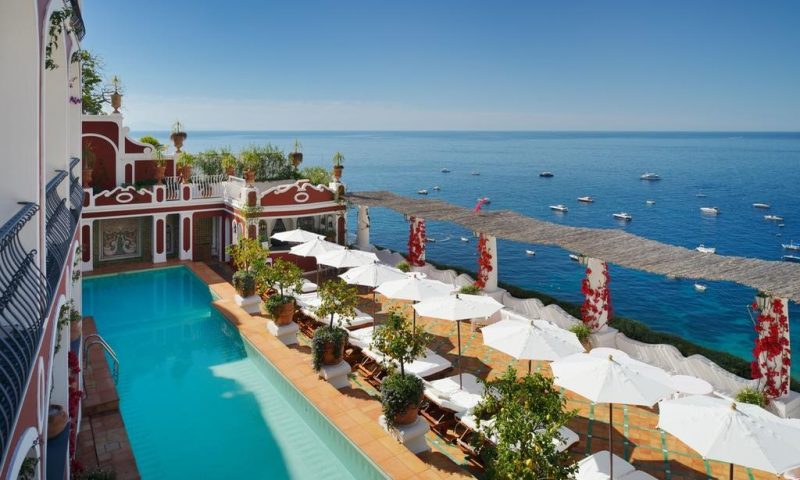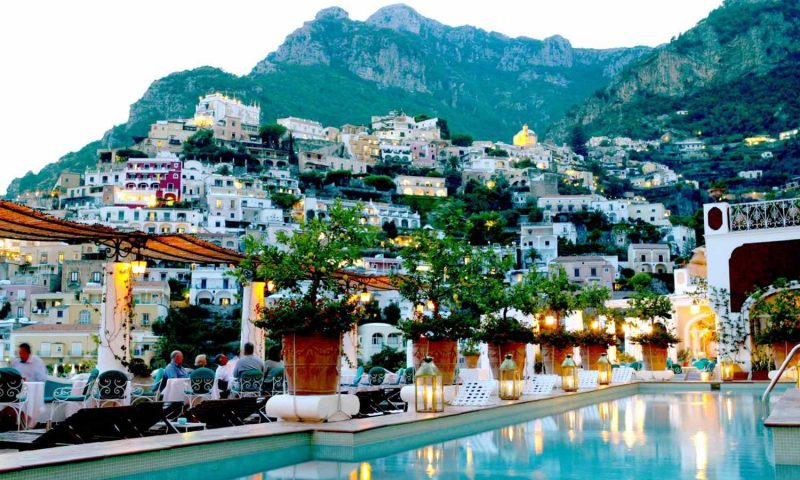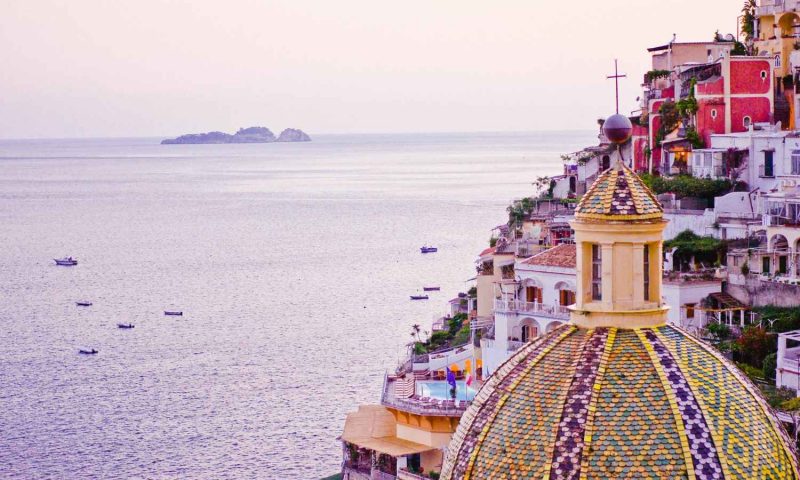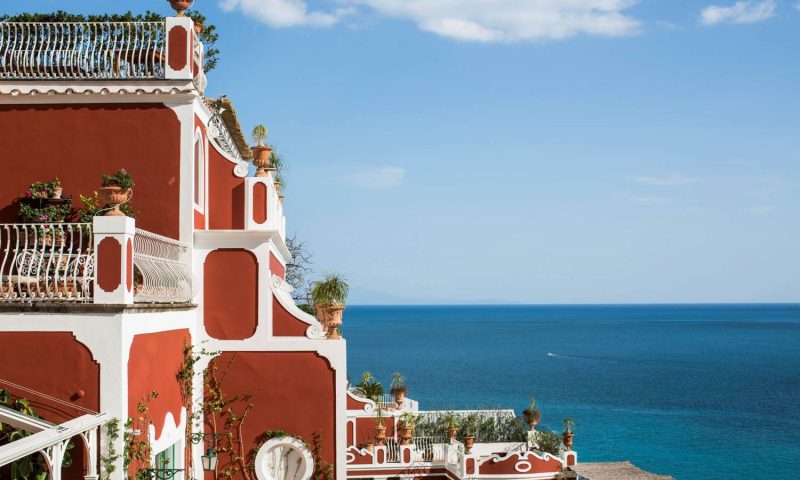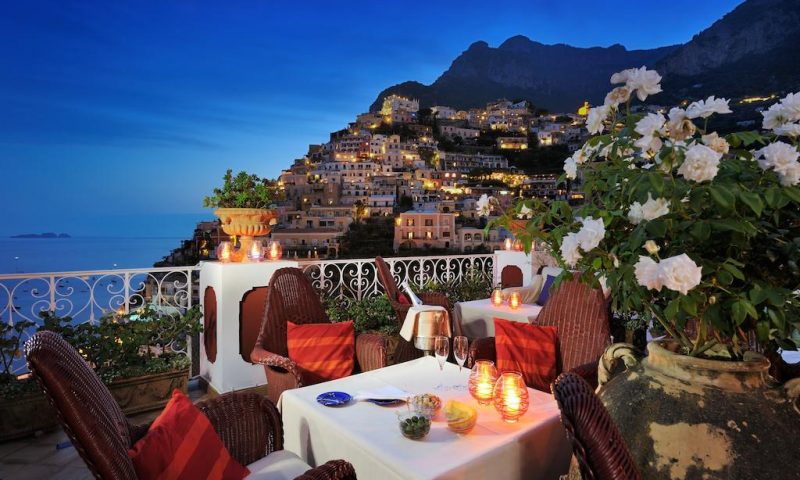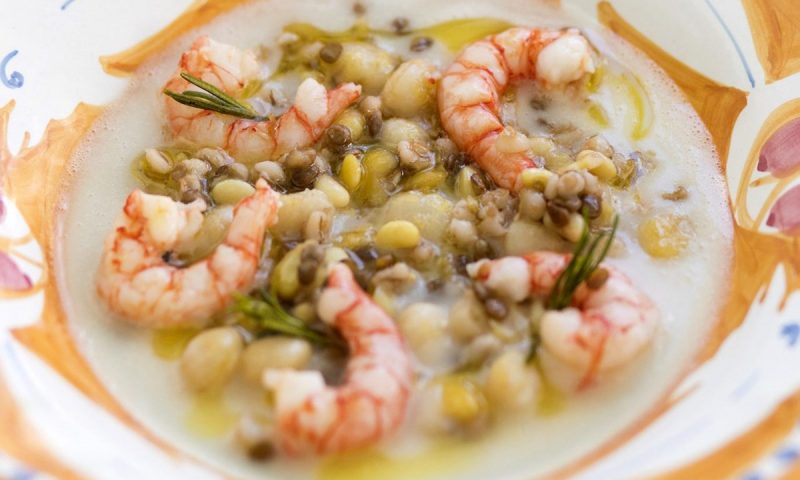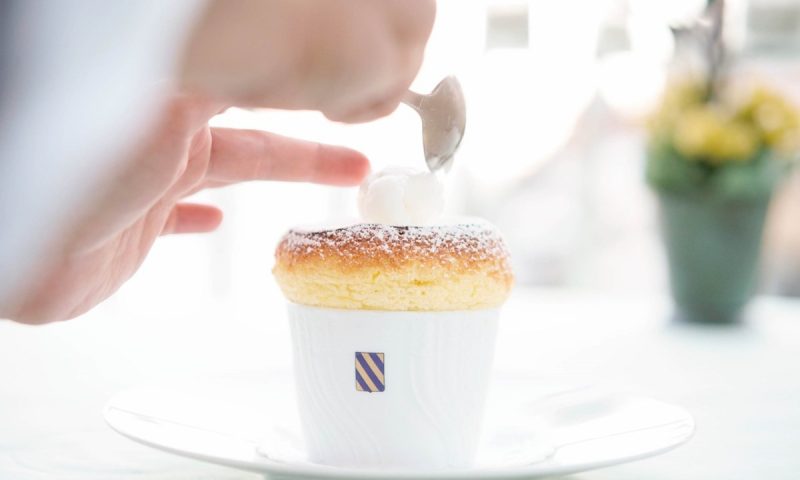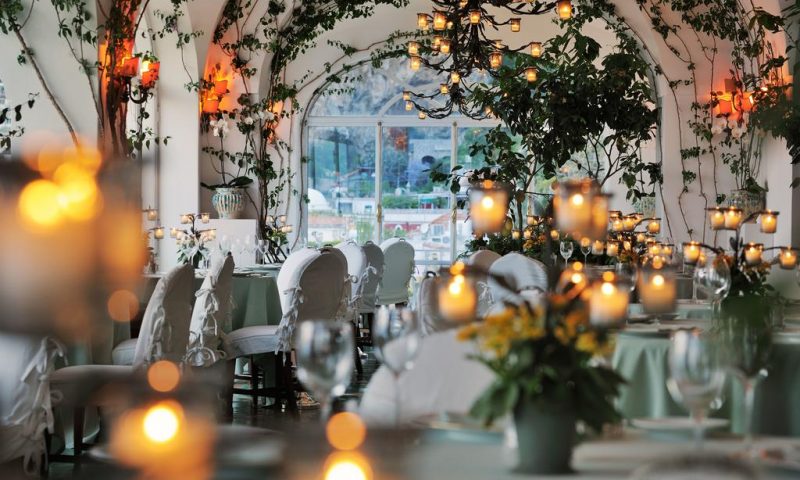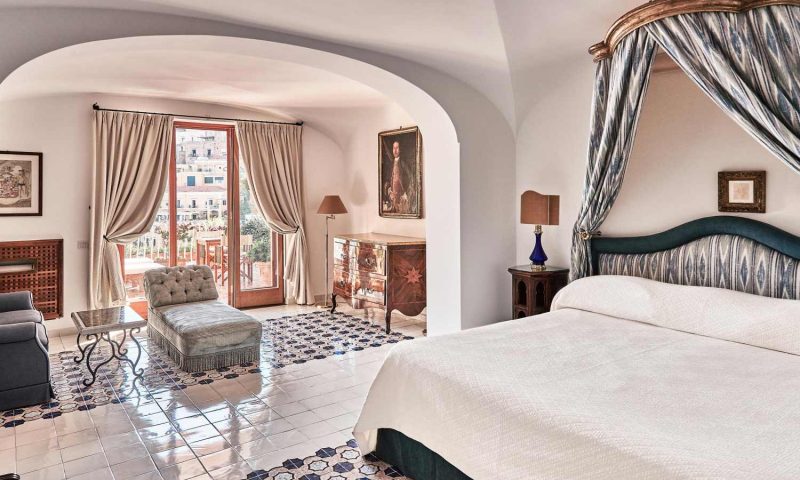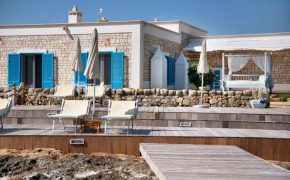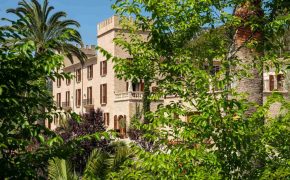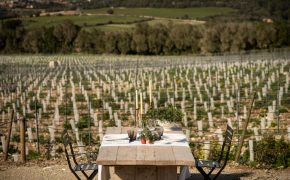Le Sirenuse is a wonderful place from which to enjoy the simple pleasures of Positano and the spectacular Amalfi Coast. John Steinbeck, who visited in 1953, wrote ‘Positano bites deep. It is a dream place that isn’t quite real when you are there and becomes beckoningly real after you have gone.’
Ever since the early Middle Ages, positanesi have been travellers, crossing seas and oceans, making contacts. But we carry our small ‘vertical’ town with us wherever we go.
The azure Mediterranean in front, the mountains behind, a stack of jaunty houses, bougainvillea and lemon trees: even on a busy New York sidewalk, this picture floats somewhere in the middle distance, like a film projected on mist.
Flat landcapes and straight roads feel wrong to us. We come from a land where there are only two directions, up and down, and where routes never go direct from A to B but meander from A towards Z before eventually ending up at H, or Q, or X.
THE HISTORY
When our family discovered it between the two World Wars, Positano was a delightful seaside refuge from Naples’ summer heat and intense urban life. At first, it was where we spent the summer and the occasional weekend.
But we still felt deeply at home here. Positano and Naples share traditions, saints, recipes, dialect expressions and the wayfaring ways we inherited from our common ancestors.
Before long, siblings Anna, Aldo, Paolo and Franco Sersale found that they were spending more time at Villa Giulietta in Positano than in Naples itself.
In 1944, Paolo was even elected mayor of Positano – a mandate that would be reconfirmed three more times, until 1960. In the first year of his mayorship, he persuaded US General Mark Clark to designate Positano as an army rest resort, and the family personally hosted several Allied officers.
Looking after guests, introducing them to the things locals love to eat and drink, telling them our stories and listening to their own – these were natural extensions of the hospitality the family villa had always offered to friends and guests.
So when Villa Giulietta opened as a hotel called Le Sirenuse in 1951, it didn’t feel like such a big leap. It still doesn’t. Though we no longer live inside the house that became Le Sirenuse, we have never lost the sense that this is our home and that those who visit us here are our honoured guests. We hope we never do.
ROOMS & SUITES
Rooms are arguably the most important part of any hotel. They are, after all, where guests spend most of their time. And yet room descriptions on hotel websites are so often focus on the dull stuff: lists of facilities, floor area, aspect, types of bed, amenities.
You need those things too, of course, to decide which room to book. But they don’t answer the question of what awaits when you turn the key in the door. If it’s daytime, it’s the light that strikes you first. Le Sirenuse’s rooms and suites embrace and reflect the luminous shimmer of the Mediterranean.
White walls, repainted every winter, white ceilings, many of them in traditional Amalfi Coast cross-vault style, crisp white bedspreads, soft white cotton curtains through which the sunlight gently filters – each of the 58 rooms is a soothing, spotless realm of light.
But there’s something else that’s more difficult to put into words. It’s to do with feeling at home as soon as you settle into an elegantly upholstered sofa, or a vintage cast iron chair on your private terrace with its ridiculously beautiful view.
It’s to do with feeling at home – but also feeling that you’ve come to a place owned by people who care, who pay attention to details.
There are stories behind each of those details. Stories about floor tiles designed especially for the hotel and fired in the centuries-old kilns of an ancient Salerno ceramics firm.
Stories of the late Franco Sersale’s passion for collecting antique furniture, artworks and Suzani rugs, and of his unerring instinct, when he saw a promising item in an auction catalogue, of knowing exactly where it would find a home, in just that corner of just that room.
Stories of a contemporary artist who was asked to create a video work that greets guests as they enter, because most hotel TV welcome messages are just so darned boring.
Stories of the bathroom amenities by Eau d’Italie, a fragrance and body care brand born at Le Sirenuse out of the Sersale family’s desire to capture the heady scents and emotions of Positano.
At Le Sirenuse, no two rooms are alike. All have a history of little improvements and adjustments, of careful, continuous curation. Each one is the hotel in miniature, a little world of Italian seaside simplicity, charm and elegance.
TWO BEDROOMS SUITE
Our most spacious Suite combines a Junior Suite Superior Sea View and separate living room with a Deluxe Sea View room to create a magnificent two-bedroom suite with three bathrooms, one with a double whirlpool bathtub overlooking the sea.
ONE BEDROOM SUITE
Located on our highest floors, the One Bedroom Suites enjoy a full sea view. They consist of one large and comfortable Junior Suite Superior Sea View and a separate living room. They have two bathrooms, one with a double whirlpool bathtub overlooking the sea.
JUNIOR SUITE
The Junior Suite Superiors have a full sea view and are located on our highest floors. They are our most spacious Junior Suites, with a comfortable sitting area and a private balcony or terrace. They also feature a sumptuous indoor jacuzzi bath overlooking the sea.
LA SPONDA RESTAURANT
At first, it’s the view that fells you. Seen from the al fresco pool terrace, where dinner is served in warmer weather, or framed in the great arched windows of a verdant, candlelit dining room, Positano’s jaunty stack of houses and its iridescent church dome are so close you feel you could reach out and touch them.
There are summer days when the setting sun drapes a golden path across the water all the way across to Li Galli, the Siren Islands, and nights in early fall when the afterglow where the sea meets the sky seems to flare up just before it fades.
No wonder so many marriage proposals have been made here over the years (not all of them planned). Of an evening, the soft glow helps, cast by hundreds of suspended candles that take a waiter called Raffaele three hours to light in the evening and almost as long to extinguish.
But musicians Franco and Andrea have to shoulder their share of blame too, for making things so damn romantic. Their lilting guitar and mandolin melodies have melted many a heart.
Any chef will tell you that stunning backdrops like this are a challenge. How to compete? The answer, according to La Sponda’s executive chef Gennaro Russo, is to understand where all that beauty comes from.
That Positano view that we snap in a second and post on Instagram is the result of years, decades, centuries, aeons of slow growth and symbiosis, geological, environmental and human.
So is what’s on the plate. Take an apparently simple dish of pasta al pomodoro, or a line-caught fish grilled to perfection, or a Neapolitan babà dessert, the sponge so light and fluffy you can cut it with the side of a fork. There are stories in there you wouldn’t believe – stories of navigators and peasants, fishermen and princes.
There are heritage grains, ancient tomato varieties, there’s oil made from olives that arrived in the Bay of Naples with the Ancient Greeks, recipes that criss-crossed the Mediterranean from Constantinople to the Straits of Gibraltar and evolved in the process. And then there are the years of technique.
These days, so many restaurants bang a big drum about their ‘fresh, local and seasonal’ approach. Honestly, why would you eat any other way? Gennaro Russo has been doing fresh, local and seasonal since he first began to cook at home in Somma Vesuviana.
That’s just the way they do things around here. You won’t find peas on the menu in September or pumpkin in April.
To extend the season, he and his kitchen brigade use time-honoured techniques like drying, preserving and bottling, or turn to trusted artisanal producers of piennolo tomatoes, Mediterranean anchovies, smoke-cured provolone cheeses.
But it’s not enough just to find the perfect ingredients – you need to respect them too. The trick, Gennaro believes, is to listen to the land, to its culture, its produce, and then distil what you’ve learned to its purest essence. Any chef worth their salt can do fancy. The really difficult thing is to do simple.
LA NUOVA DOLCE VITA BAR
On a warm summer’s evening in Positano, as dusk throws shapes and shades over the glassy Mediterranean, there’s a buzz in the air. People are dressing up, draping soft linen over sun-warmed, salt-dusted skin. A breeze rises gentle from the sea, voices and glasses begin to tinkle and chime. It’s aperitivo time.
Decisions, decisions. Will it be cool, glamorous Franco’s, magical, intimate Aldo’s, or shall we cocoon in a snug corner of the Don’t Worry Bar and watch the barmen do their thing, shaking that shaker, jigging that jigger, muddling that muddler? What a nice problem to have.
Aldo’s is, to quote Cole Porter, a delightful, delicious and even (dare we say it) delovely place to while away an evening with friends or that special other.
It’s a candlelit terrace that projects like a raft above the town and beach, but it’s also a sheltered al fresco salotto shaded by verdant greenery, where champagne winks, wine glints, cocktails clink, conversation flows, ambient music lulls and lifts, and light Mediterranean dishes mean there’s no need to move on for dinner when you’re having such a good time right where you are.
Dedicated to Aldo Sersale, one of Le Sirenuse’s founders, and a man who loved life, food, women and wine with pari passu passion, it’s both welcoming and intimate, a sociable meeting spot and a place for a hushed romantic tête-à-tête.
As for the menu… well, you know those times when dinner beckons but you feel like something fresh, easy and seasonal, not necessarily a full four-course meal?
That’s Aldo’s. Oysters, fresh-off-the-boat seafood, Neapolitan classics, healthy vegetarian and vegan salads and sides, followed perhaps by the last word in tiramisù – Aldo’s is all about how simple the good things in life can be. If that’s not la nuova dolce vita, we don’t know what is.
Hiding in plain sight, Le Sirenuse’s original hotel bar nestles in a discreet corner of the suite of living rooms at the heart of the Sersale family home that became a hotel in 1951. It’s a real insiders’ bar, one of those tucked-away shrines to classic cocktail culture that inspire such affection among aficionados of the genre.
The bar area itself is a jewel case in gold leaf, walnut, brass and precious onyx, sensitively restored and restyled in 2020 by interior designer Annalisa Bellettati. At its centre is a precious antique acquired by Franco Sersale – the walnut-veneer workdesk of an 18th century Neapolitan jeweller, bearing on its intarsio facade personifications of Europe, America, Asia and Africa.
Dedicated to those who have spent a liftetime chasing the ultimate Old Fashioned or the non plus ultra Negroni, the bar’s name pays tribute to a more recent work of art that hangs from the ceiling of the adjacent room: British artist Martin Creed’s neon installation Don’t Worry.
THE SPA
The Spa at Le Sirenuse seems to have three or four different entrances, each of them somehow secret, as if there were no front door. When you’re there, it’s a place apart, a floating world of teak, glass and steel, a quiet space that soothes and moves to a gentler rhythm, reassuring, enveloping.
Designed by renowned Italian architect Gae Aulenti, it is lined by black and white photographs taken by Franco Sersale during his travels in the East.
They too take us into another mindspace – what critic Luigi Malerba, writing of Sersale, calls “a singularity… which helps us to travel in distant lands many miles but also many centuries from our Western Europe”.
Inside the Spa is a sauna, a granite steam bath and an ice room – an atmospheric space with a ground ice cascade, illuminated by backlit crystal onyx walls. Among the treament rooms, a Spa Suite, with steam bath and emotional shower, is set aside for couples.
Massages, aromatherapy rituals, reflexology, acupressure, body rehydration and detoxification, exfoliation peels, restorative eyes therapy – Le Sirenuse’s expert therapists are trained in a wide range of treatments, and make it their priority to listen to guests and customise treatments to suit individual needs.
The Spa only uses organic, natural AVEDA products and treatments, inspired by ancient Ayurvedic ideas and practices. At the core of AVEDA’s philosophy is the belief that peace is both a state of mind and body, one that governs and nurtures our physical beauty.
THE GYM
After a night of la dolce vita, or a day of too many dolci, it’s good to know that Le Sirenuse’s gym is there for you, should you need it.
Equipped with the latest TechnoGym cardiovascular workout machines alongside weights, resistance bands, yoga and pilates mats and other equipment, the gym also features two of the very few Megaformers in Italy.
Developed by Lagree Fitness in Los Angeles, the Megaformer is a total-body workout machine, a kind of turbo-charged pilates designed to deliver a healthy, well-toned and sculpted body.
With a dedicated, full-time coach, Le Sirenuse’s fitness programme extends well beyond the gym to embrace vigorous hikes and al fresco exercise routines on the network of ancient footpaths in the hills behind Positano – a key feature of the hotel’s twice-yearly Dolce Vitality fitness and detox retreat.
THE POOL
Surrounded by lemon trees and bougainvillea, Le Sirenuse’s cool slick of a pool, with its pristine white sun loungers and deckchairs, is a little corner of peace with stunning sea views, where you can do lengths, work on your tan, or simply indulge in a little dolce far niente.
CHASING BELLEZZA
We came across Franco Sersale’s auction records just the other day. They make for impressive reading.
For at least thirty years, right up until he passed away in 2015, the man who more than anyone else was the design curator and taste arbiter of Le Sirenuse would comb the catalogues of auction houses worldwide and throw himself into the bidding with gusto, in order to secure precious antique furnishings, prints or works of art for the hotel he loved – the hotel that had once been his family’s seaside home.
He enriched Le Sirenuse with hundreds of beautiful objects, and always knew exactly where to place them (often this would be a guest room – for Franco, these were just as important as the ‘public’ parts of the hotel).
Much of the furniture or art he assembled is firmly in the 17th and 18th century Neapolitan and southern Italian tradition that is the bedrock of Le Sirenuse’s aesthetic. But Franco had eclectic tastes, and there are plenty of neo-Moorish items too – not to mention an important collection of Central Asian suzani rugs.
At the same time, Franco enthusiastically embraced the Sersale family tradition of working closely with skilled Italian artisans – local ones for preference – to restore but also to embellish and extend the fabric of a hotel that grew up around an ancient Amalfi Coast villa with its traditional cross-vaulted rooms.
For Le Sirenuse’s floor tiles or stucco panelling, for its flowerpots, rattan chairs, marble bathroom tops and a host of other fittings, furnishings, tableware and amenities, Franco sought out firms and individual artisans who combine a respect for tradition with dedication to quality and creative verve.
No detail, whether it be a cocktail glass, a bedspread or a room key, was too small to escape his attention.
The Sersale family has continued in his footsteps, abetted today by the synergy between Le Sirenuse and two of its close cousins: Carla Sersale’s fashion and lifestyle brand Emporio Sirenuse, and the Eau d’Italie fragrance and skincare line established by Marina Sersale and Sebastián Alvarez Murena.
In 2015, the Artists at Le Sirenuse contemporary art programme was launched by Antonio and Carla Sersale in collaboration with British curator Silka Rittson-Thomas to celebrate Positano’s long connection with creativity, and to continue in a more modern vein the passion for collecting that bubbled over in Antonio’s father Franco – but which in reality has shaped the hotel since the beginning.
Each year, a living artist is invited to create a site-specific work within the hotel, in dialogue with the surroundings and the spirit of place.
To date, works by Martin Creed, Stanley Whitney, Alex Israel, Matt Connors, Rita Ackermann and Caragh Thuring have been unveiled, blowing like a fresh new breeze through Le Sirenuse’s elegant historic palimpsest.
There’s one more part of the story still to tell, and it’s a vital one. Le Sirenuse doesn’t have a hotel garden, because it is a garden. Plants are everywhere, on the terraces, in the rooms, in the lobby, lounges, bars and corridors.
The bougainvillea that climbs the walls of La Sponda restaurant is justly famous, as are the lemon trees, immortalised in numberless Instagram posts, that flank the pool or stand as solitary sentinels, in ornate terracotta pots emblazoned with the Sersale family crest, on the lobby terrace or at the centre of Franco’s Bar.
The Strelitzia nicolai or Bird of Paradise plant at the entrance to Aldo’s Cocktail Bar & Seafood Grill has even been immortalised in paint – by US artist Alex Israel, whose trompe l’oeil mural Amalfi Dr., 2017 takes the palm on a graceful dance up the stairs that lead to the lobby.
The planting scheme, curated by landscape architect Isabella Casali di Monticelli, is inspired by the walled gardens and terraces of old Positano houses, while day to day care of the plants, and the many adjustments that each season brings, falls to a team of gardeners overseen by Giulia Sersale.
ACTIVITIES & EXCURSIONS
Le Sirenuse is designed to help you resist those well-meaning but slightly annoying friends who say “You mean you went all the way to Positano and you didn’t go to Pompeii?”
We love active guests, but we also love those who want to do nothing more than chill in a beautiful place for a week, and we especially like those who come full of plans and end up doing nothing except chilling for a week in this beautiful place we call home.
WEEKLY ACTIVITIES
However, chilling and recharging one’s energy reserves doesn’t mean sitting still. That’s why we’ve put together a weekly calendar of activities that take place in and around the hotel and are all entirely free of charge to our guests.
Among them are a wine tasting with the sommelier, a pre-breakfast pilates workout, a cocktail-mixing lesson and a short but testing trek up 1,865 steps to Nocelle, a ‘perched’ village with stunning views down the coast.
Twice a year, in March and November, Le Sirenuse organizes the non plus ultra of activities: Dolce Vitality an entire week of fitness, healthy eating and restorative yoga in one of the world’s best-equipped open-air gyms – the Amalfi Coast.
MESSING AROUND IN BOATS
That coastline takes on an entirely different aspect when seen from the sea, and it’s no surprise that one of our most perennially popular activities is an excursion on the Sant’Antonio, a glorious old fishing boat that used to belong to our bon viveur of an uncle, Aldo Sersale.
Another evergreen classic is the boat ride to lunch at Nerano, a seaside village whose stellar restaurants and trattorias are well-known to Amalfi Coast insiders.
And those who book a stay of at least three nights in one of our Suites or Junior Suites are treated to an excursion on the vintage Riva speedboat that is the Sersale family’s pride and joy.
EXPLORING THE REGION
But to go back to those annoying friends – they’re right in one way. A unique example of an ancient town frozen at one moment in time, Pompeii is spectacular. And it’s just one of the draws in an area overflowing with cultural riches and natural wonders.
Vesuvius, Naples with its rich, chaotic urban life, lesser-known archaeological sites such as Oplontis (which inspired the wine-red hue of our hotel facades), Amalfi and Ravello, Capri and Ischia – you could spend a month here and still not see everything. (Equally, you could spend a month here just chilling out).
Le Sirenuse is not just a hotel, it’s a curator of unique experiences. We love it when guests bombard us with questions about where to go, who to talk to, where to eat, what to avoid – but also when they tell us about discoveries they have made.
In the ongoing Le Sirenuse Guide, which is being published in instalments in our online magazine Sirenuse Journal, we are revealing some of our own and our friends’ secrets. But not all – we like to keep a few to share with you in person, in Positano!
